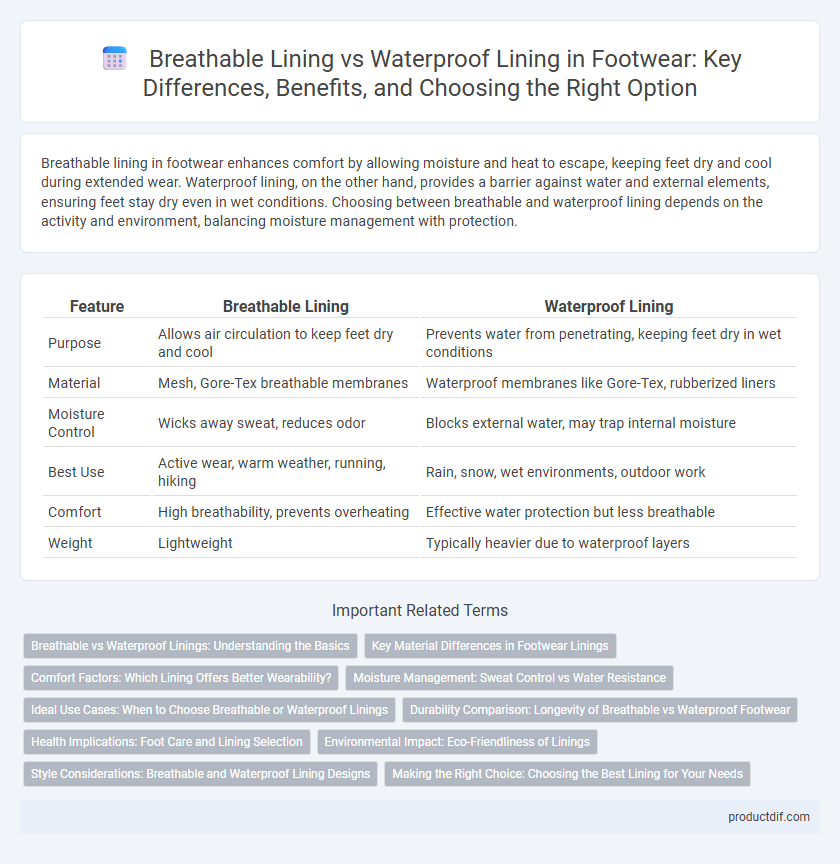Breathable lining in footwear enhances comfort by allowing moisture and heat to escape, keeping feet dry and cool during extended wear. Waterproof lining, on the other hand, provides a barrier against water and external elements, ensuring feet stay dry even in wet conditions. Choosing between breathable and waterproof lining depends on the activity and environment, balancing moisture management with protection.
Table of Comparison
| Feature | Breathable Lining | Waterproof Lining |
|---|---|---|
| Purpose | Allows air circulation to keep feet dry and cool | Prevents water from penetrating, keeping feet dry in wet conditions |
| Material | Mesh, Gore-Tex breathable membranes | Waterproof membranes like Gore-Tex, rubberized liners |
| Moisture Control | Wicks away sweat, reduces odor | Blocks external water, may trap internal moisture |
| Best Use | Active wear, warm weather, running, hiking | Rain, snow, wet environments, outdoor work |
| Comfort | High breathability, prevents overheating | Effective water protection but less breathable |
| Weight | Lightweight | Typically heavier due to waterproof layers |
Breathable vs Waterproof Linings: Understanding the Basics
Breathable linings in footwear are designed with materials like Gore-Tex or mesh that allow moisture vapor to escape, keeping feet dry and comfortable during extended wear. Waterproof linings create a sealed barrier to prevent any water ingress, ensuring feet stay dry in wet conditions but may reduce airflow, potentially causing sweat buildup. Choosing between breathable and waterproof linings depends on activity type and environmental exposure, balancing moisture management with water resistance for optimal foot health.
Key Material Differences in Footwear Linings
Breathable linings in footwear commonly use materials like mesh, Gore-Tex, and moisture-wicking fabrics designed to allow air circulation and prevent sweat buildup. Waterproof linings often incorporate impermeable membranes such as TPU (thermoplastic polyurethane) or coated materials that block water penetration while retaining some breathability. The key material difference lies in breathable linings prioritizing airflow and moisture vapor transmission, whereas waterproof linings focus on creating a barrier against external water intrusion.
Comfort Factors: Which Lining Offers Better Wearability?
Breathable linings in footwear enhance moisture-wicking and ventilation, reducing sweat accumulation and preventing odors, which significantly improves all-day comfort. Waterproof linings provide protection against external wet conditions, ensuring dry feet but often sacrificing breathability, which can lead to discomfort in prolonged wear. For optimal wearability, breathable linings excel in comfort during dry or moderately wet conditions, while waterproof linings prioritize dryness at the cost of airflow.
Moisture Management: Sweat Control vs Water Resistance
Breathable lining in footwear excels at moisture management by allowing sweat vapor to escape, keeping feet dry and comfortable during extended wear. Waterproof lining provides a robust barrier against external water, preventing rain and puddles from penetrating but may trap sweat inside. Effective sweat control in breathable linings reduces odor and blisters, while waterproof linings prioritize water resistance for protection in wet environments.
Ideal Use Cases: When to Choose Breathable or Waterproof Linings
Breathable linings are ideal for active outdoor activities in dry, warm conditions where moisture-wicking and ventilation prevent overheating and blisters. Waterproof linings are essential for wet, cold environments, providing reliable protection against rain, snow, and puddles while maintaining warmth. Choosing between breathable or waterproof linings depends on climate, activity level, and the need for moisture management versus water resistance.
Durability Comparison: Longevity of Breathable vs Waterproof Footwear
Breathable linings, made from materials like mesh or moisture-wicking fabrics, offer enhanced comfort but may wear out faster due to increased exposure to moisture and abrasion. Waterproof linings, often constructed from durable membranes such as Gore-Tex, provide superior protection against water ingress and typically exhibit greater longevity in harsh conditions. The durability comparison favors waterproof footwear for extended use in wet environments, while breathable footwear suits dry or moderate conditions with shorter lifespan concerns.
Health Implications: Foot Care and Lining Selection
Breathable linings in footwear promote moisture evaporation and air circulation, reducing the risk of fungal infections and keeping feet dry and healthy. Waterproof linings prevent water ingress, offering protection in wet environments but may trap sweat, potentially leading to bacteria growth and foot odor. Selecting the right lining depends on individual foot health needs, activity level, and environmental conditions to balance comfort and infection prevention.
Environmental Impact: Eco-Friendliness of Linings
Breathable linings are typically made from natural or recycled materials like mesh and organic cotton, reducing environmental impact through better air circulation and biodegradability. Waterproof linings often rely on synthetic membranes such as Gore-Tex, which can contain non-biodegradable components and involve energy-intensive manufacturing processes. Choosing breathable linings contributes to lower carbon footprints and less microplastic pollution, promoting sustainable footwear production.
Style Considerations: Breathable and Waterproof Lining Designs
Breathable lining designs in footwear prioritize lightweight, mesh-based materials that enhance airflow and moisture-wicking properties, making them ideal for summer styles and activewear. Waterproof lining incorporates materials like Gore-Tex or treated membranes that offer reliable protection against water while maintaining a sleek, robust appearance suitable for urban and outdoor fashion trends. Choosing between breathable and waterproof linings impacts not only comfort but also influences the aesthetic, with breathable linings favoring casual, sporty looks and waterproof linings supporting rugged, weather-resistant styles.
Making the Right Choice: Choosing the Best Lining for Your Needs
Breathable linings, often made from mesh or moisture-wicking fabrics, excel at promoting air circulation and reducing foot sweat, making them ideal for warm weather or high-activity footwear. Waterproof linings, typically constructed from materials like Gore-Tex or other membrane laminates, are designed to prevent water penetration while maintaining some breathability, essential for wet or unpredictable conditions. Selecting the best lining depends on your primary needs: prioritize breathable linings for comfort and dryness in dry climates and waterproof linings for protection against moisture during outdoor adventures or rainy environments.
Breathable Lining vs Waterproof Lining Infographic

 productdif.com
productdif.com